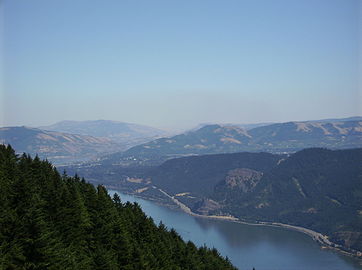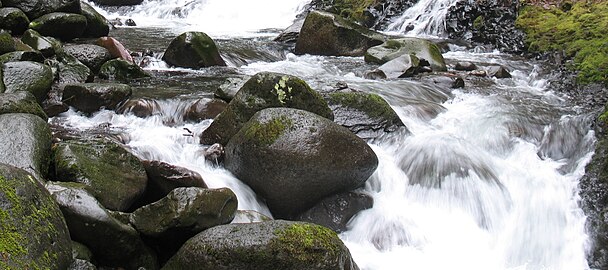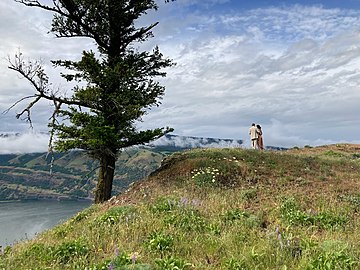Columbia River Gorge
| Columbia River Gorge | |
|---|---|
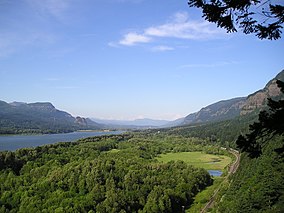 Looking east up the Columbia River Gorge from nearMultnomah Falls. | |
 | |
| Location | Pacific Northwest, United States |
| Established | 1986 |
| Website | www |
TheColumbia River Gorgeis acanyonof theColumbia Riverin thePacific Northwestof the United States. Up to 4,000 feet (1,200 m) deep, the canyon stretches for over eighty miles (130 km) as the river winds westward through theCascade Range,forming the boundary between the state ofWashingtonto the north andOregonto the south.[1]Extending roughly from the confluence of the Columbia with theDeschutes River(and the towns ofRoosevelt, Washington,andArlington, Oregon) in the east down to the eastern reaches of thePortland metropolitan area,thewater gapfurnishes the only navigable route through the Cascades and the only water connection between theColumbia Plateauand thePacific Ocean.It is thus that the routes ofInterstate 84,U.S. Route 30,Washington State Route 14,and railroad tracks on both sides run through the gorge.
A popular recreational destination, the gorge holds federally protected status as theColumbia River Gorge National Scenic Areaand is managed by the Columbia River Gorge Commission and theU.S. Forest Service.
Description
[edit]The Columbia River,Klamath Riverinnorthern California,Pit Riverin northern California, andFraser Riverin southernBritish Columbiaare the only four rivers connecting the watersheds on the east side of theCascade Rangeto thePacific Ocean.Each river has carved out a gorge through the Cascades. The Columbia River Gorge marks the state line between Oregon and Washington, and its wide range of elevation and precipitation makes it an extremely diverse and dynamic place. Ranging from 4,000 feet (1,200 m) to sea level, and transitioning from 100 inches (2,500 mm) of precipitation to only 10 inches (250 mm) in 80 miles (130 km), the gorge provides the setting for a diverse collection ofecosystems,from thetemperate rain foreston the western end—with an average annual precipitation of 75 to 100 inches (1,900 to 2,500 mm)—to the eastern grasslands with average annual precipitation between 10 and 15 inches (250 and 380 mm), to a transitional dry woodland betweenHood RiverandThe Dalles.[citation needed]Isolatedmicro-habitatshave allowed for many species ofendemicplants and animals to prosper, including at least 13 endemic wildflowers.
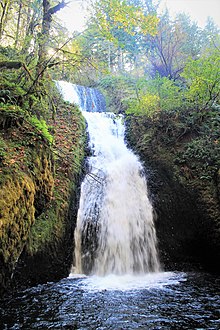
The gorge transitions between temperate rainforest to dry grasslands in only 80 miles (130 km), hosting a dramatic change in scenery while driving alongInterstate 84.In the western, temperate rainforest areas, forests are marked bybigleaf maples,Douglas fir,andwestern hemlock,all covered inepiphytes.In the transition zone (between Hood River and The Dalles), vegetation turns toOregon white oak,ponderosa pine,andcottonwood.At the eastern end, the forests make way for expansivegrasslands,with occasional pockets oflodgepoleand ponderosa pine.
Atmospheric pressuredifferentials east and west of the Cascades create awind tunneleffect in the deep cut of the gorge, generating 35-mile-per-hour (56 km/h) winds that make it a popularwindsurfingandkiteboardinglocation. It also creates the right conditions for snow and ice storms during the winter months which also draw very cold east winds toward the mouth of the gorge on the west end.
The gorge is a popular destination forhiking,biking,sightseeing,fishing,andwater sports.The area is known for its high concentration ofwaterfalls,with over 90 on the Oregon side of the gorge alone.[2]Many are along theHistoric Columbia River Highway,including the notable 620-foot-high (190 m)Multnomah Falls.
Trails and day use sites are maintained by theForest Serviceand many Oregon and Washingtonstate parks.
Geology
[edit]The Columbia River Gorge began forming as far back as theMiocene(roughly 17 to 12 million years ago), and continued to take shape through thePleistocene(2 million to 700,000 years ago). During this period theCascade Rangewas forming, which slowly moved the Columbia River's delta about 100 miles (160 km) north to its current location.[3]
Although the river slowly eroded the land over this period of time, the most drastic changes took place at the end of thelast ice agewhen theMissoula Floodscut the steep, dramatic walls that exist today, flooding the river as high up asCrown Point.[4]This quick erosion left many layers ofvolcanic rockexposed.[3]
Ecology
[edit]The Columbia River Gorge is home to a number of plant species that are endemic or found mostly in the gorge and surrounding areas, includingHeterotheca villosa,Lomatium columbianum,Lomatium klickitatense,Lomatium suksdorfii,Penstemon barrettiae,andPrimula poetica.[5]
History
[edit]
The gorge has supported human habitation for over 13,000 years. Evidence of theFolsomandMarmespeople, who crossed theBering land bridgefromAsia,were found inarchaeological digs.Excavations nearCelilo Falls,a few miles east ofThe Dalles,show humans have occupied thissalmon-fishing site for more than 10,000 years.[citation needed]
The gorge has provided a transportation corridor for thousands of years.Native Americanswould travel through the gorge to trade at Celilo Falls, both along the river and overLolo Passon the north side ofMount Hood.In 1805, the route was used by theLewis and Clark Expeditionto reach the Pacific.[6]Early European and American settlers subsequently establishedsteamboat linesand railroads through the gorge. Today, theBNSF Railwayruns freights along the Washington side of the river, while its rival, theUnion Pacific Railroad,runs freights along the Oregon shore. Until 1997, Amtrak'sPioneeralso used the Union Pacific tracks. The Portland segment of theEmpire Builderuses the BNSF tracks that pass through the gorge.
TheColumbia River Highway,built in the early 20th century, was the first major paved highway in thePacific Northwest.Shipping was greatly simplified afterBonneville DamandThe Dalles Damsubmerged the gorge's major rapids such as Celilo Falls, a major salmon fishing site for local Native Americans until the site's submergence in 1957.
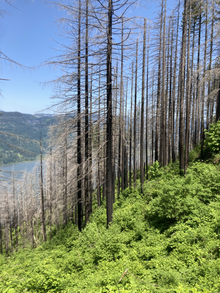
In November 1986,Congressmade the gorge the secondU.S. National Scenic Areaand established theColumbia River Gorge Commissionas part of aninterstate compact.[7]The experimental designation came in lieu of being recognized as anational park,which would require the existing industries in towns along the river to relocate. The designation was initially opposed by residents fearing government encroachment, due to restrictions in the plan for items such as building paint colors, and was also opposed by conservationists who feared additional development in the region.[8]In 2004, the gorge became the namesake of theColumbia Gorge American Viticultural Area,a 4,432-acre (1,794 ha) area located on both sides of the river.
In fall 2017, theEagle Creek Fireburned in the gorge for three months, consuming almost 50,000 acres (78 sq mi; 200 km2). It reached 100% containment on November 30, 2017, but was not yet completely out.[9]
Gallery
[edit]-
Crown Pointin the Columbia River Gorge, looking upstream fromChanticleer Point
-
Columbia River Gorge, photographed from the southern edge of theGifford Pinchot National Forest
-
The view east towards The Dalles fromDog Mountain
-
Native American petroglyphs in the Columbia River Gorge nearThe Dalles Dam
-
Kitesurfingon the Columbia River
-
View of Columbia River Gorge from Cape Horn Trail, looking east towardBeacon Rock
-
Columbia River Gorge, photographed from Crown Point.
-
Triple Falls
-
Oneonta Creek
-
Horsethief Butte, nearThe Dalles
-
A couple overlooks the Columbia River Gorge from a viewpoint nearMosier, Oregon
-
A view of the Oregon side of the Columbia River Gorge from Hamilton Mountain
-
Columbia River Gorge with Mount Adams and Mount Saint Helens barely visible, seen from the Devils Rest Trail
See also
[edit]- Barlow Road,the first wagon-compatible pioneer road to provide a safer alternative to traveling through the gorge
- Cascades Rapids
- Proposed Columbia Gorge casino,a proposed off-reservation casino in Cascade Locks
- Wahclella Falls
- Nancy Neighbor Russell,conservationist and co-founder of Friends of the Columbia Gorge
References
[edit]- ^Staats, David (November 21, 1983)."The Gorge".Spokane Chronicle.(Washington). Associated Press. p. A15.
- ^"Columbia River Gorge of Oregon".Northwest Waterfall Survey. Retrieved February 6, 2011.
- ^ab"Columbia River Gorge".Northwest Power and Conservation Council.2021.Archivedfrom the original on July 8, 2007.RetrievedJune 2,2008.
- ^Dietrich, William (September 30, 2007)."Trailing An Apocalypse".The Seattle Times, Pacific Northwest Magazine.RetrievedOctober 23,2021.
- ^"iNaturalist".Retrieved January 6, 2023.
- ^O'Connor, Jim E. (Fall 2004)."The Evolving Landscape of the Columbia River Gorge: Lewis and Clark and Cataclysms on the Columbia".Oregon Historical Quarterly.105(3): 390–421.doi:10.1353/ohq.2004.0043.S2CID131976728.Archived fromthe originalon March 28, 2009.
- ^Columbia River Gorge National Scenic Area ActArchived2015-04-08 at theWayback Machinefrom GorgeFriends.org
- ^Geranios, Nicholas K. (June 3, 1990). "Columbia Gorge controversy smolders".The Seattle Times.Associated Press. p. B3.
- ^Ryan, Jim (November 30, 2017)."Columbia Gorge fire declared 100 percent contained; hot spots still possible".The Oregonian.RetrievedDecember 5,2017.
External links
[edit]- U.S. Forest Service- Columbia River Gorge National Scenic Area
- Columbia River Gorge Commission
- TheGorgeMagazine
- Abbott, Carl."Columbia Gorge National Scenic Area".The Oregon Encyclopedia.
- Portland State University Columbia River Gorge National Scenic Area Collection—contains research material used to write the book Planning a New West: The Columbia River Gorge National Scenic Area
- The River They SawDocumentary produced byOregon Public Broadcasting
- Columbia River Gorge
- Archaeological sites in Oregon
- Archaeological sites in Washington (state)
- Valleys of Oregon
- Valleys of Washington (state)
- Protected areas of Clark County, Washington
- Columbia River
- Protected areas of Hood River County, Oregon
- Protected areas of Klickitat County, Washington
- Protected areas of Multnomah County, Oregon
- National scenic areas
- Protected areas of Sherman County, Oregon
- Protected areas of Skamania County, Washington
- Protected areas of Wasco County, Oregon
- Mount Hood National Forest
- Landforms of Clark County, Washington
- Landforms of Hood River County, Oregon
- Landforms of Klickitat County, Washington
- Landforms of Multnomah County, Oregon
- Landforms of Sherman County, Oregon
- Landforms of Skamania County, Washington
- Landforms of Wasco County, Oregon
- United States Forest Service protected areas
- Water gaps of Washington
- Water gaps of the United States




